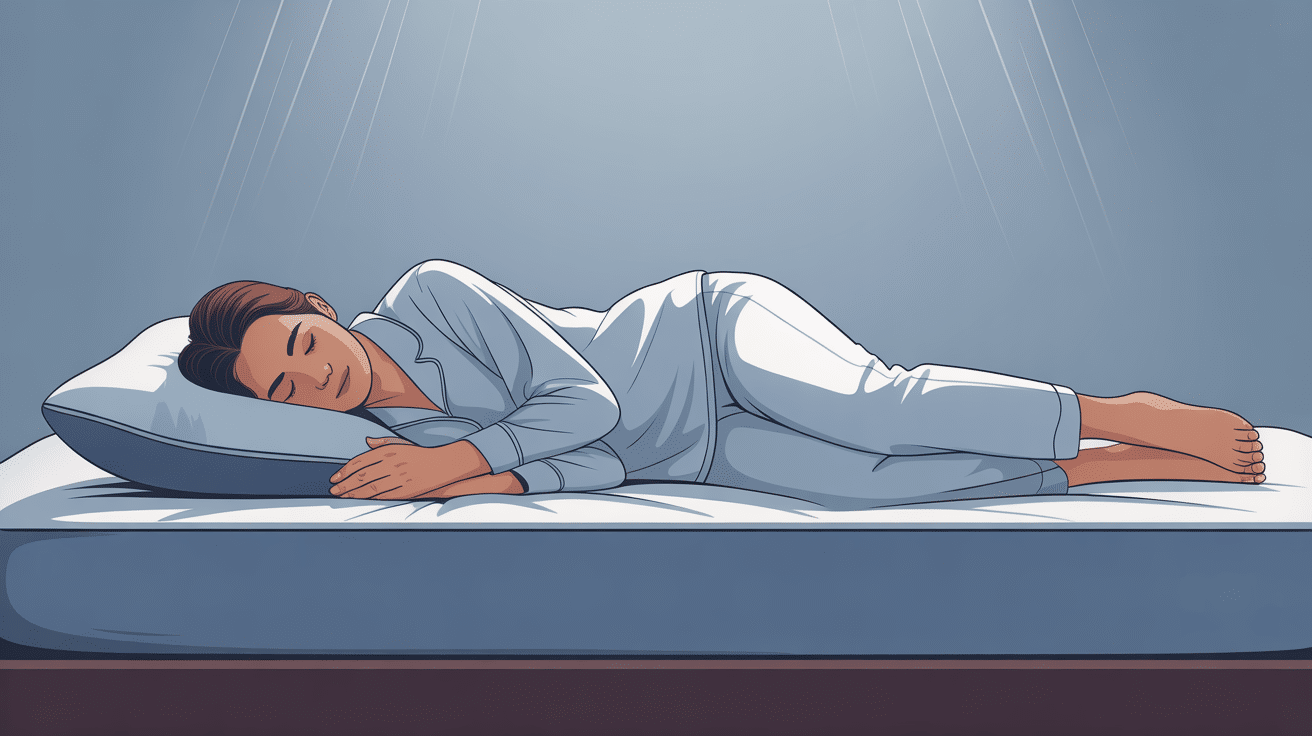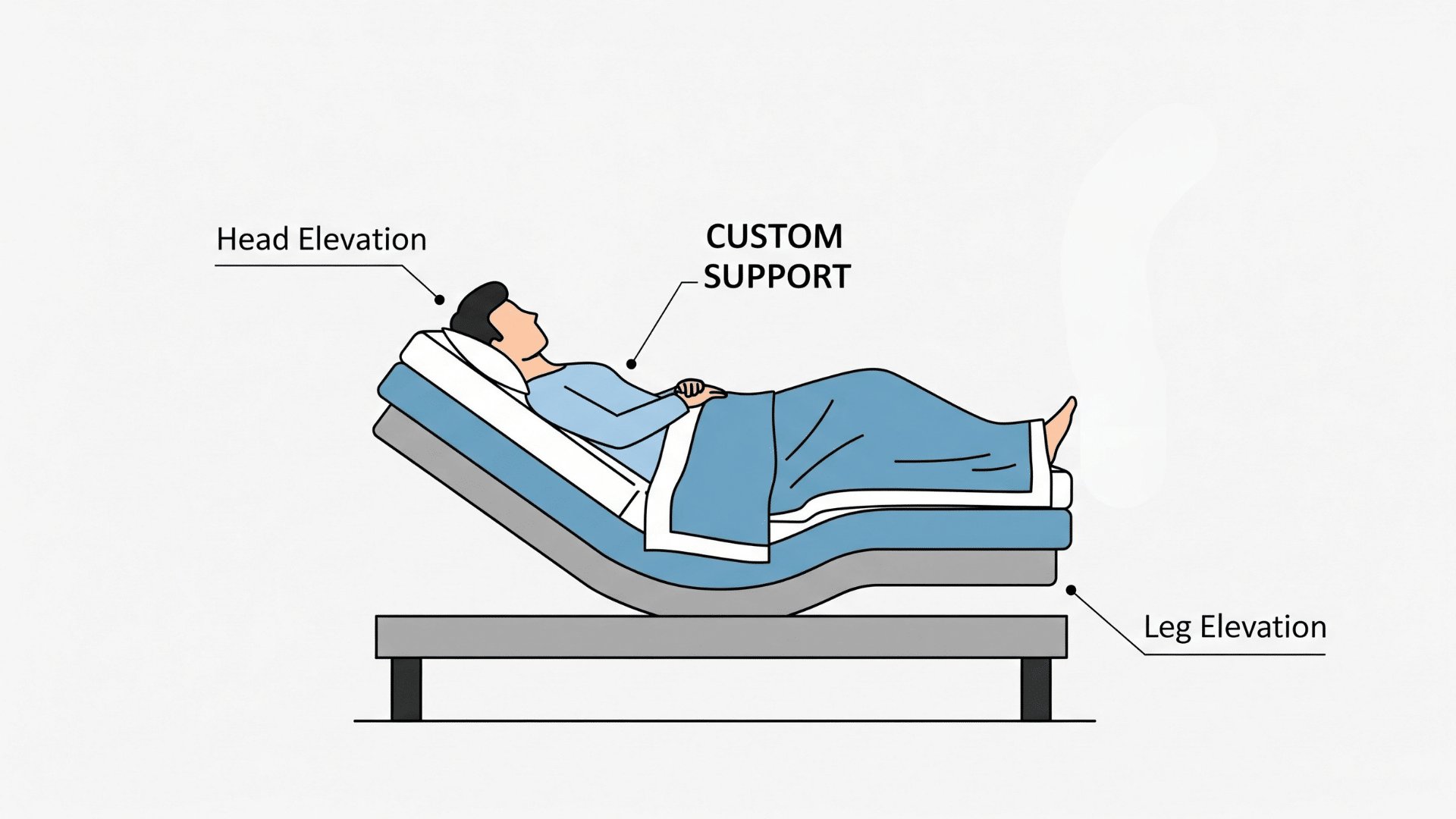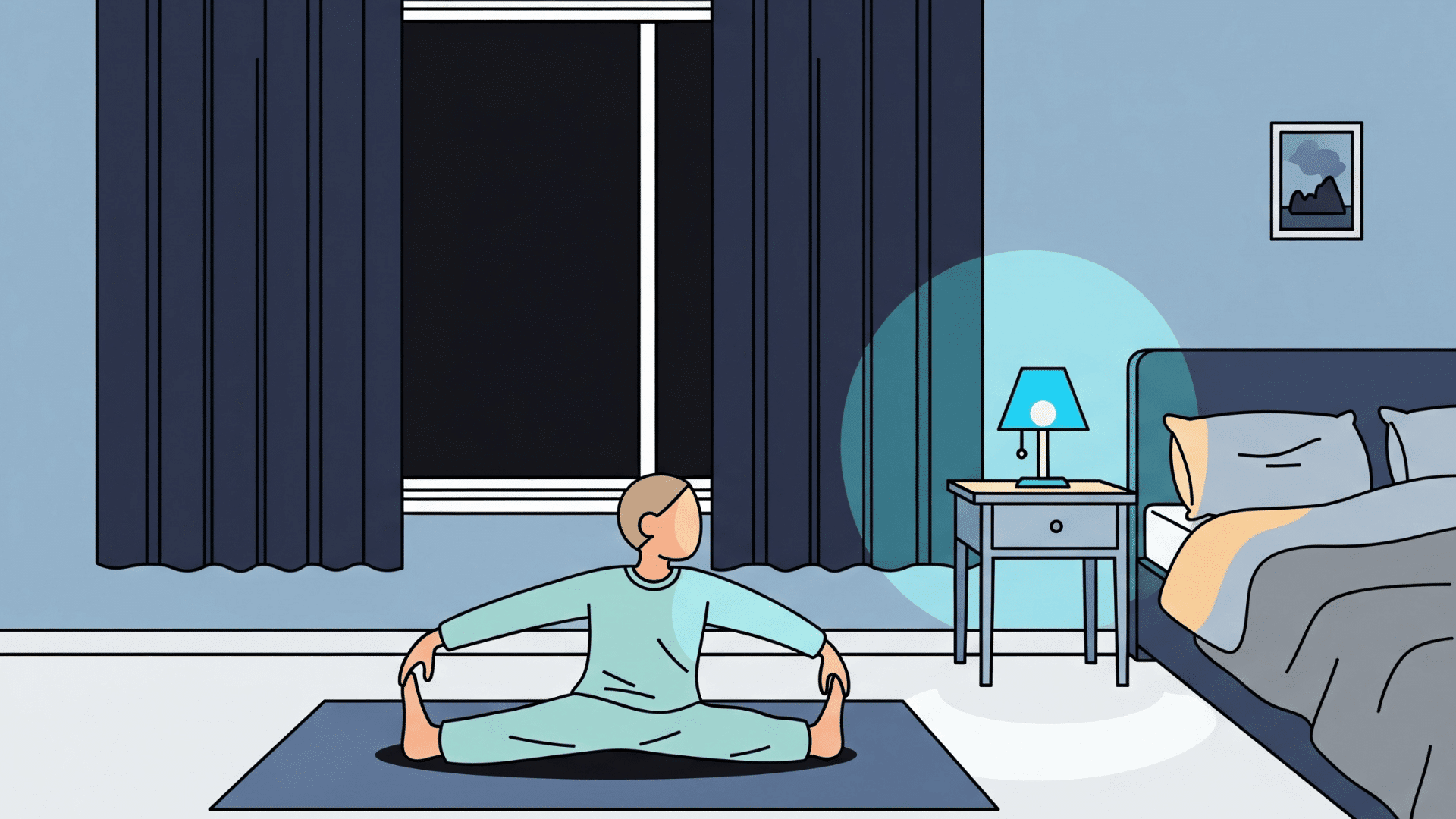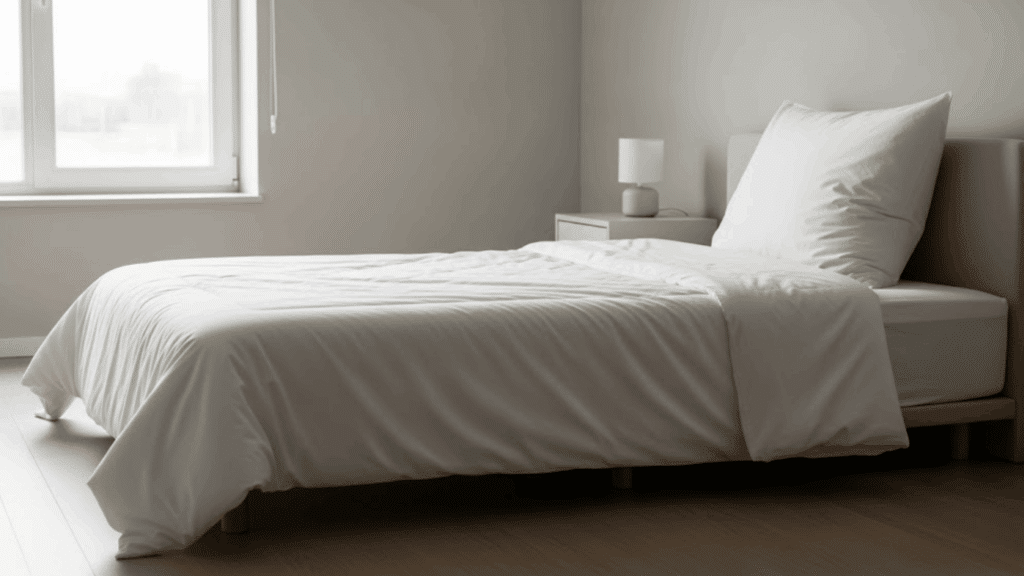A thoracic herniated disc can turn bedtime into a painful struggle. This condition affects the middle part of your spine, causing discomfort that makes it hard to find a comfortable sleeping position.
Many people find themselves tossing and turning all night, unable to get the rest they need.
Quality sleep is crucial for healing and managing pain, but disc problems can make this feel impossible.
The good news is that with the right sleeping positions and helpful tips, you can get better rest and wake up feeling more comfortable.
This guide will walk through the best sleeping positions, mattress choices, and practical strategies to help you sleep better with thoracic disc pain.
By making a few simple changes, you can improve your sleep quality and support your body’s natural healing process.
What Is a Thoracic Herniated Disc?
A thoracic herniated disc occurs in the middle section of your spine, between your neck and lower back.
This area has 12 vertebrae that connect to your ribcage and protect vital organs like your heart and lungs.
When a disc herniates in this area, the soft inner material pushes through the tough outer layer. This can put pressure on nearby nerves or the spinal cord itself.
The thoracic spine is naturally more stable than other areas, so herniations here are less common but can be more serious.
How Does It Disrupt Sleep?
Thoracic disc problems create several sleep challenges that can leave you exhausted and in pain. Understanding why this happens can help you find better solutions for comfortable rest.
- Mid-back pain increases – Lying flat can put pressure on the affected disc area
- Radiating discomfort – Pain may spread around your ribcage or into your arms
- Muscle stiffness develops – Your back muscles tense up to protect the injured area
- Position changes hurt – Rolling over or getting up from bed becomes painful
Best Sleeping Positions for Thoracic Herniated Disc Relief

Finding the right sleeping position can make a huge difference in your comfort level. These positions help reduce pressure on your spine and support natural alignment.
1. Side Sleeping with Pillow Support
Side sleeping in a slightly curled position is often the most comfortable for thoracic disc issues. Place a pillow between your knees to keep your spine aligned and prevent rotation.
Choose the side that feels most comfortable, as this may vary from person to person. Keep your hips stacked on top of each other throughout the night.
Note: If one side causes more pain, try sleeping on the opposite side to reduce pressure on the affected disc area.
2. Back Sleeping with Knee Elevation
Back sleeping distributes your weight evenly and can provide relief for thoracic disc pain. Place a pillow under your knees to maintain the natural curve of your lower back.
Make sure your head pillow supports your neck without pushing it too far forward. Your ears should align with your shoulders when lying on your back.
Note: This position works best on a medium-firm mattress that supports your spine’s natural curves without letting you sink too deeply.
3. Keep Your Head and Neck Aligned
Your pillow should keep your neck in a neutral position, not too high or too low. The goal is to maintain the natural curve of your cervical spine while you sleep.
Consider using a contoured pillow designed for spinal support, or adjust your current pillow by folding or adding/removing filling to get the right height.
Note: Poor neck alignment can create tension that travels down your spine and worsens thoracic disc symptoms, so pillow choice is crucial.
Other Helpful Sleep-Related Tips for Herniated Discs

Beyond sleeping positions, several other factors can improve your sleep quality and reduce thoracic disc pain throughout the night.
1. Alignment Is Key
Maintaining proper alignment while sleeping and changing positions protects your spine from additional strain. Focus on keeping your ears, shoulders, and hips in a straight line.
Use pillows to fill any gaps between your body and the mattress. This extra support helps maintain your natural spinal curves throughout the night.
When changing positions, move your body as one unit instead of twisting. Roll over slowly and use your arms and legs together to maintain alignment.
2. Choose the Right Mattress
Your mattress plays a crucial role in supporting your spine and reducing thoracic disc pain. The right firmness level can make a significant difference in your comfort and healing.
| Your Situation | Best Mattress Type | Why It Helps |
|---|---|---|
| Severe pain when lying down | Medium-firm memory foam | Contours to reduce pressure points |
| Pain when changing positions | Hybrid with responsive coils | Makes movement easier at night |
| Stiffness in the morning | Latex mattress | Provides supportive bounce and alignment |
| Budget constraints | Medium-firm innerspring with topper | Affordable support with added comfort |
| Hot sleeper with disc pain | Cooling gel hybrid | Combining support with temperature control |
Medium-firm mattresses typically work best for disc problems, providing support while still contouring to your body’s shape. They prevent excessive sinking while cushioning pressure points.
3. Pick a Suitable Pillow by Sleep Style
Different sleeping positions require different pillow heights and support levels. Choosing the right pillow for your preferred position helps maintain proper spinal alignment.
Back sleepers need a thinner pillow that supports the natural curve of their neck without pushing the head too far forward.
Side sleepers require a thicker pillow to fill the gap between their shoulder and neck, keeping the spine straight.
Combination sleepers may benefit from an adjustable pillow that can be modified for different positions throughout the night.
4. Use a Mattress Topper (If Needed)
If you can’t replace your current mattress, a quality mattress topper can provide additional comfort and support. This is an affordable way to improve your sleep surface without buying a new mattress.
Choose a topper that adds the right amount of cushioning for your needs. Memory foam toppers provide contouring, while latex toppers offer more responsive support.
A good topper can also make it easier to change positions during the night by reducing pressure points and friction.
5. Consider an Adjustable Bed
Adjustable beds allow you to elevate different parts of your body for optimal comfort and spinal alignment. This can be especially helpful for thoracic disc issues by reducing pressure on your spine.
- Leg elevation – Reduces spinal compression and improves circulation
- Head positioning – Helps find the most comfortable angle for your upper body
- Custom support – Allows you to adjust throughout the night as needed
- Easy position changes – Makes getting in and out of bed less painful
- Investment consideration – Higher cost but significant comfort improvement potential
Lifestyle Changes That Support Better Sleep

Making changes to your daily routine and sleep environment can help reduce thoracic disc pain and improve your overall sleep quality.
1. Create a Sleep-Friendly Environment
Your bedroom environment plays a big role in sleep quality and pain management. Small changes can make a big difference in how well you rest.
Keep your bedroom cool, dark, and quiet to promote deeper sleep. Use blackout curtains or an eye mask to block light, and consider earplugs or a white noise machine for sound control.
Establish a consistent bedtime routine and sleep schedule. Going to bed and waking up at the same time each day helps regulate your body’s internal clock.
2. Physical Therapy & Movement
Staying active during the day can help reduce thoracic disc pain and improve your sleep quality. Gentle exercises and stretches support spinal health and reduce stiffness.
Work with a physical therapist to learn safe exercises that strengthen your core and back muscles. Stronger muscles provide better support for your spine.
Avoid sitting or lying in one position for too long during the day. Take regular breaks to move and stretch, which can prevent stiffness that interferes with sleep.
3. Mind-Body Connection: Pain and Stress
Chronic pain and stress can create a cycle that interferes with sleep and healing. Learning to manage both can improve your overall well-being and sleep quality.
Practice relaxation techniques like deep breathing, meditation, or gentle yoga before bedtime. These activities can help calm your mind and reduce muscle tension.
Consider working with a counselor who specializes in chronic pain management. Cognitive behavioral therapy can provide tools for coping with pain and improving sleep.
When Medication Helps
Sometimes medication can be a helpful part of your pain management and sleep improvement plan. Always work with your healthcare provider to find the right approach for your situation.
Over-the-counter anti-inflammatory medications can help reduce pain and inflammation that interferes with sleep. Follow dosing instructions and check with your doctor about long-term use.
Muscle relaxants may help if muscle spasms are contributing to your sleep problems. Some people also benefit from medications that address both pain and sleep issues.
For severe cases, steroid injections may provide longer-lasting relief that allows for better sleep and healing. Discuss all options with your healthcare team.
Ergonomic Tips for Sitting During the Day
How you sit during the day can affect your thoracic disc pain and sleep quality at night. Good posture and ergonomic support help prevent additional strain on your spine.
- Maintain proper posture – Keep your back straight and shoulders relaxed while sitting
- Use lumbar support – A small pillow or cushion can help maintain your spine’s natural curve
- Position feet properly – Keep both feet flat on the floor or use a footrest
- Take frequent breaks – Stand and move for a few minutes every 30-60 minutes
- Adjust your workspace – Make sure your computer screen and keyboard are at the right height
Getting Better Sleep with a Thoracic Herniated Disc
Living with a thoracic herniated disc doesn’t mean you have to accept poor sleep forever.
The right sleeping positions, mattress support, and lifestyle changes can make a significant difference in your comfort and rest quality.
Start with the sleeping positions and pillow adjustments that feel most comfortable for your body.
Remember that everyone’s pain is different, so you may need to try several approaches to find what works best.
Combine these strategies for the best results, and don’t hesitate to work with healthcare professionals for additional support.
Ready to start sleeping better tonight? Try one new positioning tip from this guide and see how it affects your comfort. Share your experience or questions in the comments – your insights could help other readers find relief too!
Frequently Asked Questions
What Is the Best Sleeping Position for a Thoracic Herniated Disc?
Side sleeping with a pillow between your knees is often most comfortable, but back sleeping with knee support can also provide relief.
Should I Use a Firm or Soft Mattress for My Disc Problem?
Medium-firm mattresses typically work best, providing support while still contouring to your body’s pressure points.
Can an Adjustable Bed Help with Thoracic Disc Pain?
Yes, adjustable beds allow you to find the most comfortable position and can reduce pressure on your spine during sleep.





